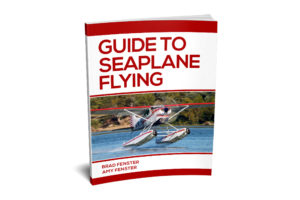Seaplane Preflight
The preflight inspection is a crucial step in any flight, and seaplanes are no exception. Most of the preflight will be the same for a seaplane as for a land-based aircraft. However, there are some elements unique to seaplanes.
General
The following items are unique to seaplanes:
- • Preflight can be made more difficult if the plane is sitting in the water. Only the top of the floats will be visible, and it may be difficult to get to the other side of the plane. If possible, it may be easiest to preflight the aircraft when it is out of the water, such as when on a trailer or an amphibian on land.
- The floats should be inspected for any cracks, holes, or gaps.
- Pay attention to the way the seaplane sits in the water. The water line should be about the same each time, depending on the current load. Sitting at an unusual attitude for a given load can indicate that a float compartment is filled with water. A small amount of water in the floats is normal and should be pumped out during preflight. Large amounts of water point to a leak in the float that should be fixed before the aircraft is flown. The amount of water pumped from the floats should be monitored to help identify possible damage to the floats. If there is an increase in the amount of water removed, the floats may be in need of repair.
- Corrosion is a concern for seaplanes, particularly if they operate in salt water. Make sure to check the seaplane for signs of corrosion. A small amount of corrosion can significantly weaken a structure and corrosion on float seams is a common factor in leaking floats.
- Given the water environment, the fuel system should be sumped. The wing fuel tanks should be sumped first. If lower sumps are drained first, water may enter the fuel lines but not reach the lower sump. If this occurs, water may be ingested by the engine in a critical time during the takeoff run.
Amphibians
In addition to the standard seaplane preflight items, amphibious planes include other inspections and concerns due to the wheeled landing gear. These checks should be performed when the aircraft is on land, including:
- Inspecting the landing gear for wear, damages, etc. Particular attention should be paid to corrosion or damage to the landing gear rigging. These are critical components in the overall working of the gear and problems during a water landing can be disastrous.
- Greasing or lubricating the landing gear. Water has a deteriorating effect on most grease. Only approved grease should be used.
- Checking the stance of the aircraft. When on land, the amphibian should sit at a proper level. Any changes in this stance may indicate a problem with the struts or other landing gear components, which may require servicing from a mechanic.
- Ensuring proper tire inflation. Underinflated front tires are a significant factor in shimmy on landings.
- Checking hydraulic fluid level as applicable during the preflight. Also, checking for hydraulic fluid when pumping the floats. If there is an oily sheen on the water, there may be a hydraulic leak as the fluid from the leak will often pool in the floats. Pumping the floats allows the pilot to see if there is hydraulic fluid in the compartments. If there is easy access to the float compartments, all of the hydraulic connections and seals should be inspected for signs of leaks.
DEFINITIONS:
Bilge Pump: A pump used to extract water that has leaked into the bilge of a float or flying boat
Water Line: The line made by the horizontal surface of the water on the float or hull when afloat.
QUESTIONS:
How might the pilot know if there is a hydraulic leak with an amphibian? There may be an oily sheen on the water after pumping the floats.
How often should the floats be pumped? At a minimum the floats should be pumped prior to the initial flight of the day. Depending on the volume of flying and the condition of the floats, they may need to be pumped multiple times throughout the day.
Can a preflight of a seaplane be conducted while it’s in the water? Yes. The pilot can conduct a preflight inspection while the seaplane is in the water. However, some aspects of the inspection may not be feasible, such as checking an amphibian’s main gear.
How much water is too much in the floats? This depends on the aircraft. Overtime, the floats will often leak more and more due to wear and/or damage. Monitor the volume of water pumped and ensure that any significant changes are evaluated for damage and any needed repairs. A good rule of thumb is that there is excess water seepage if more than a quart of water is pumped out.

